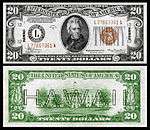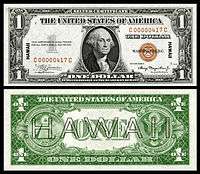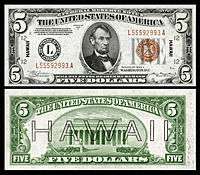Hawaii overprint note
| (United States) | |
|---|---|
| Value | $1, $5, $10, $20 |
| Years of printing | 1942 – 1944 |
| Nature of rarity | Emergency Issue |
| Estimated value | US$2 - $1,300 |
| Obverse | |
 | |
A Hawaii overprint note is one of a series of banknotes (one silver certificate and three Federal Reserve Notes) issued during World War II as an emergency issue after the attack on Pearl Harbor. The intent of the overprints was to easily distinguish US currency captured by Japanese forces in the event of an invasion of Hawaii and render the bills useless.
Issue
After the attack on Pearl Harbor, military officials surmised that in the event of an invasion of Hawaii, Japanese forces would have access to a considerable amount of US currency that could be seized from financial institutions or private individuals. Faced with this scenario, on January 10, 1942, Military Governor Delos Carleton Emmons issued an order to recall all regular US paper money in the islands, save for set caps on how much money both individuals ($200) and businesses ($500; save extra currency for payroll purposes) could possess at any time.[1][2][3][4]
On June 25, 1942, new overprinted notes were first issued. Series 1935A $1 silver certificate, Series 1934 $5 and $20 Federal Reserve Notes, and Series 1934A $5, $10, and $20 Federal Reserve Notes from the Federal Reserve Bank of San Francisco were issued with brown treasury seals and serial numbers. Overprints of the word HAWAII were made; two small overprints to the sides of the obverse of the bill between the border and both the treasury seal and Federal Reserve Bank of San Francisco seal, and huge outlined HAWAII lettering dominating the reverse. The hope was that should there have been a Japanese invasion, the US government could immediately declare any Hawaii-stamped notes worthless, due to their easy identification.[1][3][5][6]
With this issue, military officials made the use of non-overprinted notes redundant and ordered all Hawaii residents to turn in unstamped notes for Hawaii-stamped notes by July 15.[4][5][6] Starting from August 15, 1942, no other paper currency could be used except under special permission.[1]
| HAWAII Overprint Notes | |||||||||||
|---|---|---|---|---|---|---|---|---|---|---|---|
| Image | Value | Dimensions | Main Color | Description | Date of | Catalog # | |||||
| Obverse/Reverse | Obverse | Reverse | Watermark | printing | issue | withdrawal | |||||
 |
$1 silver certificate | 6.140 × 2.610 in (155.956 × 66.294 mm) | Green; Black | George Washington | Great Seal of the United States | None | June 25, 1942 | April, 1946 | Friedberg F-2300 Friedberg F-2300*[7] | ||
 |
$5 Federal Reserve Note | 6.140 × 2.610 in (155.956 × 66.294 mm) | Green; Black | Abraham Lincoln | Lincoln Memorial | None | June 25, 1942 | April, 1946 | Friedberg F-2301 Friedberg F-2301* Friedberg F-2302 Friedberg F-2302*[8] | ||
 |
$10 Federal Reserve Note | 6.140 × 2.610 in (155.956 × 66.294 mm) | Green; Black | Alexander Hamilton | US Treasury Building | None | June 25, 1942 | April, 1946 | Friedberg F-2303 Friedberg F-2303*[9] | ||
 |
$20 Federal Reserve Note | 6.140 × 2.610 in (155.956 × 66.294 mm) | Green; Black | Andrew Jackson | White House | None | June 25, 1942 | April, 1946 | Friedberg F-2304 Friedberg F-2304* Friedberg F-2305 Friedberg F-2305*[10] | ||
Destruction of recalled notes
Faced with a $200 million stockpile of US currency, military officials opted to destroy all the recalled currency instead of overcoming the logistical problems of shipping the currency back to the mainland.[3][4][5][6] At first, a local crematorium[a] was pressed into service to burn the notes. To ensure complete destruction, a fine mesh was placed on the top of the smokestacks to catch and recirculate unburnt scraps of currency escaping the fire.[3]
Progress on the destruction was slow, and pressed with time, the bigger furnaces of the Aiea sugar mill were requisitioned to help burn the currency.[3][4][5][6]
Use
The notes and issuance continued in use until October 21, 1944;[1][3][4][5][6] by April 1946, notes were being recalled.[4] Many notes were saved as curios and souvenirs by servicemen.
As a collectible
Of the series, the $5 note is considered the most desirable, as a little over 9 million examples were printed. Over 35 million $1 notes were made, making them the most common of the series. Star Notes exist for all the notes, and command a sizable premium.
| Denomination | Quantity Printed | Star Note Quantity Printed | References |
|---|---|---|---|
| $1 | 35,052,000 | 204,000 | [7] |
| $5 | 9,416,000 | ? | [8] |
| $10 | 10,424,000 | ? | [9] |
| $20 | 11,246,000 | 54,500 | [10] |
Notes
- a. ^ Simpson notes Oahu Cemetery as the first burn site;[3] however, Medcalf notes Nuuanu Mortuary as the first burn site when interviewed by the Honolulu Advertiser.[4]
References
- 1 2 3 4 Friedberg, pg. 20
- ↑ Budnick, p. 93
- 1 2 3 4 5 6 7 Simpson Inside Cover
- 1 2 3 4 5 6 7 Krauss, Bob (2005-07-27). "Wartime currency not so rare". Honolulu Advertiser. Retrieved 2009-07-10.
- 1 2 3 4 5 Budnick, p. 97
- 1 2 3 4 5 Budnick, Rich (2008). "Sakamoto's Swimming Success". Generations Hawaii. Retrieved 2009-07-10.
- 1 2 Friedberg pg 44-45
- 1 2 Friedberg pg 108
- 1 2 Friedberg pg 160
- 1 2 Friedberg pg 208-209
- Budnick, Rich (2005). Hawaii's Forgotten History: the good...the bad...the embarrassing. Aloha Press. ISBN 0-944081-04-5.
- Friedberg, Arthur L. & Ira S. (2008) The Official Red Book. A Guide Book Of United States Paper Money: Complete Source for History, Grading, and Prices (Second Edition) Whitman Publishing ISBN 0-7948-2362-9
- Simpson, MacKinnon (2008). Hawaii Homefront: Life in the Islands during World War II. Bess Press. ISBN 978-1-57306-281-7.